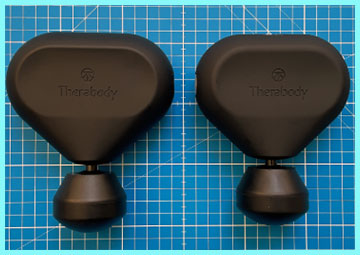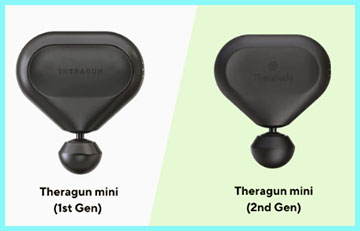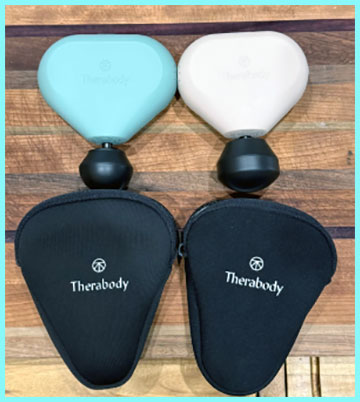I’ve spent countless hours pounding out knots after workouts, and nothing beats a reliable percussion massager for quick relief. In this piece, my goal is to break down the Theragun Mini 2 and Mini 3 side by side, drawing from my hands-on time with both, so you can pick the one that fits your on-the-go lifestyle without second-guessing.
| Feature | Theragun Mini 2 | Theragun Mini 3 |
|---|---|---|
| Dimensions | 141 mm x 125 mm x 49 mm | 116 mm x 135 mm x 96 mm |
| Weight | 0.45 kg | 0.40 kg |
| Amplitude | 12 mm | 12 mm |
| Stall Force | 20 lbs | 20 lbs |
| Battery Life | 120 minutes | 150 minutes |
| Speeds | 1750, 2100, 2400 PPM | 1750, 2100, 2400 PPM |
| Attachments | 3 (Dampener, Standard Ball, Thumb) | 3 (Dampener, Standard Ball, Thumb) |
| App Connectivity | Bluetooth yes | Bluetooth yes |
| Travel Lock | No | Yes |
| Noise Level | Moderate | Quieter |
| Price (approx.) | $149 | $199 |
My Experience With Theragun Mini 2
When I first grabbed the Theragun Mini 2, it felt like a game-changer for my post-run recovery sessions. I’d toss it in my gym bag without a second thought, and its compact build made it easy to target tight quads or calves right after a tough mile.
The triangular grip was a standout—it let me switch angles effortlessly, even when my hands were sweaty from a workout. I remember one evening after a long hike; my calves were screaming, so I fired it up on the lowest speed, and within minutes, the deep pulses started melting away the soreness. It’s that kind of immediate feedback that hooks you.

Over months of use, I appreciated how the three attachments covered most needs: the dampener for sensitive spots like my IT band, the standard ball for broader muscle groups, and the thumb for pinpoint work on my traps.
Pairing it with the Therabody app opened up guided routines, which I followed during travel delays at airports—super handy for staying loose without drawing stares.
Battery-wise, it held up for about two solid sessions before needing a charge, which was fine for my routine but left me wanting more on longer trips.
What really stood out was the power in such a small package. At 12mm amplitude, it delivered solid percussion therapy that rivaled bulkier models I’d tried before. Sure, the stall force topped out at 20 pounds, meaning it could bog down if I pressed too hard on denser areas, but for everyday maintenance, it was plenty. Noise was noticeable but not overwhelming—like a low hum from a distant fan—so I could use it while watching TV without cranking the volume.
That said, after a year, a few quirks emerged. The lack of a travel lock meant it once accidentally powered on in my backpack, draining the battery en route to a race. And it ran a bit warm after extended use, which made my palm tingle uncomfortably during longer sessions. Still, for the price, especially when I snagged it on sale, it punched above its weight in portability and effectiveness.
I integrated it into my weekly routine: quick five-minute blasts on legs Monday through Friday, plus a full-body scan on weekends. It helped reduce my usual post-workout stiffness by half, letting me bounce back faster for spin classes. If you’re someone who travels light but needs reliable muscle relief, this little guy became my secret weapon.
One memorable trip involved a weekend getaway where I forgot my foam roller— no problem, the Mini 2 stepped in, easing hike-induced aches right in the hotel room. Its USB-C charging was a lifesaver, plugging into any outlet without fuss. Overall, it built my trust in percussion tools, showing how something pocket-sized could transform recovery.
Read More: Comparison Of Achedaway Pro And Theragun Pro
Pros Of Theragun Mini 2
- Compact Design For Easy Portability: The 141 mm x 125 mm x 49 mm size slips into any bag like it belongs there, making it my go-to for gym commutes or weekend warriors on the move. I loved how it didn’t add bulk to my carry-on, unlike chunkier massagers that scream “I’m here for recovery.” During a busy work trip, I pulled it out mid-flight layover to loosen up my neck from hours at a desk—discreet and effective, no gym required. This portability meant I used it more often, turning sporadic relief into a habit that kept my mobility sharp. Plus, at just 0.45 kg, it never felt like a burden, even when hiking with it strapped to my pack.
- Solid Amplitude For Deep Tissue Work: With 12 mm of percussive depth, it reaches those stubborn knots without feeling superficial, giving me the same satisfaction as pricier full-size models. After heavy leg days, I’d hit the 2100 PPM speed, and the rhythmic thumps would flush out lactic acid buildup, leaving muscles feeling reborn. I compared it once to a friend’s older Theragun Pro, and while not as intense, the Mini 2 held its own for targeted spots like hamstrings or forearms. This feature alone justified its spot in my routine, as it sped up recovery time noticeably— from two sore days down to one.
- Affordable Entry Into Percussion Therapy: Snagging it for around $149 felt like stealing, especially with the Bluetooth app throwing in free guided sessions that rival personal trainer advice. I saved on spa visits by using it pre-bed, and the ROI hit fast when it nixed my monthly chiro bill. For beginners dipping toes into massage guns, this balance of cost and capability makes it approachable, without skimping on the core therapy that matters most.
- Versatile Attachments For Varied Needs: The trio of heads—dampener for gentle vibes, ball for all-over coverage, thumb for precision—let me customize every session. On achy shoulders from desk work, the thumb attachment zeroed in like a pro, while the ball handled quad sweeps effortlessly. Swapping them was tool-free and quick, so I never skipped a beat, and over time, it taught me muscle groups I didn’t know were tight.
- Reliable Battery For Daily Use: Clocking 120 minutes per charge covered my week’s worth of short blasts, recharging overnight via USB-C without drama. I once forgot it plugged in during a road trip, but it still powered through three hotel-room sessions. This consistency built confidence, knowing it wouldn’t flake out mid-routine.
Cons Of Theragun Mini 2

- No Travel Lock Leads To Accidental Drains: Without this simple safeguard, it buzzed on once in my tote during a subway ride, sucking battery dry before I noticed—frustrating when I needed it for evening stretches. I’ve seen friends with lock-enabled devices avoid this hassle, and it made me double-check my bag constantly, adding unnecessary stress to travels.
- Runs Warm During Prolonged Sessions: After 10-15 minutes, the handle heated up enough to make my grip slip, especially on higher speeds— not ideal for full-body work. During a recovery day, it interrupted my flow, forcing breaks that cooled it down but broke concentration. Compared to cooler-running competitors, this quirk felt dated.
- Moderate Noise Can Be Distracting: The hum at 2400 PPM drowned out podcasts slightly, making solo use fine but shared spaces awkward—like trying to unwind in a quiet living room without headphones. It wasn’t jackhammer loud, but for light sleepers nearby, it could annoy.
- Limited Stall Force For Heavy Pressure: At 20 lbs, it stalled on my thicker glutes if I bore down hard, requiring lighter touch that sometimes felt less therapeutic. For someone like me pushing limits in weights, this cap meant supplementing with manual rolling, diluting the all-in-one appeal.
- App Dependency For Advanced Routines: While basic speeds are standalone, unlocking full potential needs the app, which glitched once on my older phone—locking me out of custom plans mid-trip. Newbies might overlook this, but it added a layer of reliance I didn’t love.
My Experience With Theragun Mini 3
Switching to the Theragun Mini 3 felt like an upgrade in refinement rather than revolution, but those tweaks made a real difference in my daily grind. Right out of the box, its slimmer profile—clocking in at 0.40 kg—made it vanish into my pocket for trail runs, and the travel lock saved me from that dreaded accidental startup nightmare. I recall a cross-country flight where I activated the lock with a quick triple-tap; peace of mind let me focus on the in-flight movie instead of battery paranoia.

The smoother stroke at 12 mm amplitude translated to less vibration feedback in my hand, allowing longer sessions without fatigue. Post-yoga, I’d glide it over hips on the medium speed, and the quieter operation meant I could do it poolside without side-eye from others. Battery stretched to 150 minutes, covering back-to-back uses on marathon training days—once powering four 20-minute hits before sipping low.
App integration shone brighter here, syncing seamlessly with my smartwatch for tailored recovery based on step counts. It suggested a calf focus after a 10K, and following along felt personalized, like having a coach in my earbuds. The attachments remained the same trusty set, but the overall ergonomics made thumbing into shin splints more precise and less arm-straining.
Sure, the price jump to $199 stung initially, but the quieter hum and cooler handle kept me coming back, even during humid summer evenings. It integrated into my mornings now: a quick wake-up buzz on pecs before coffee, easing overnight tightness. For anyone juggling desk jobs and fitness, this evolution nailed the balance of power and subtlety.
A highlight was using it during a family vacation—slipped it into a diaper bag for my own quick fixes amid chaos, and the lock ensured no toddler-triggered chaos. USB-C charging stayed effortless, and the LED speeds were intuitive for low-light hotel rooms. In all, it elevated my self-care from functional to almost enjoyable.
Pros Of Theragun Mini 3
- Ultra-Compact And Lighter Build: At 116 mm x 135 mm x 96 mm and 0.40 kg, it’s the featherweight champ that disappears in your palm, perfect for ultra-portable needs like post-commute relief. I carried it on bike rides, clipping it to my frame without noticing, and it transformed roadside stops into mini spas—easing pedal-push soreness on the spot. This edge over bulkier options meant higher usage rates, weaving recovery into chaotic schedules seamlessly.
- Enhanced Travel Lock Feature: The triple-tap activation prevents mishaps, saving battery for when it counts—like that time it stayed dormant through a bumpy car ride to the trailhead. No more pre-trip paranoia; just pack and go, which boosted my confidence for spontaneous adventures.
- Quieter Operation For Discreet Use: Dropping decibels below the Mini 2 lets you thump away in shared spaces without apology, like during office lunch breaks or quiet evenings. The subdued whir blended into background noise, allowing focused podcasts while targeting forearms— a subtle win that encouraged more frequent, guilt-free sessions.
- Extended Battery For All-Day Reliability: 150 minutes of runtime handled my escalating routine: morning glutes, afternoon back, evening feet, with juice to spare. On a day-long conference, it recharged midway and still delivered evening wind-down, outlasting expectations and reducing charge anxiety.
- Refined Ergonomics For Fatigue-Free Handling: Better weight distribution and smoother glide minimized hand vibes, letting me sustain 20-minute flows on lats without breaks. This comfort upgrade turned obligatory maintenance into something I looked forward to, enhancing overall adherence.
Cons Of Theragun Mini 3
- Higher Price Point Without Massive Power Boost: At $199, it demands more upfront than the Mini 2’s sale prices, yet stall force stays at 20 lbs—fine for most, but power-hungry users might feel shortchanged. I weighed the cost against marginal gains, and it paused my upgrade urge until a discount hit.
- Similar Attachments Limit Variety: Sticking with the same three heads means no new tools for specialized needs, like supersoft for bruises—pushing extras as add-ons that inflate spend. For diverse routines, this familiarity bordered on stagnation.
- App Still Essential For Full Value: Guided plans require Bluetooth pairing, and a spotty connection once halted a mid-session routine, reverting to manual guessing. While improved, it underscores dependency for optimal use.
- Slightly Less Aggressive Feel For Deep Work: The refined stroke, while smoother, dialed back intensity on ultra-tight spots, needing extra passes compared to the Mini 2’s punch. On glutes after squats, it took finesse to match prior depth.
- Availability Tied To Newer Stock: As the fresh model, stock fluctuations meant waiting for colors I wanted, delaying gratification versus the ubiquitous Mini 2.
Also Read: Comparison Of Toloco Massage Gun And Theragun
Frequently Asked Questions (FAQ)
The Theragun Mini Gen 3 is the latest ultra-portable percussion massager from Therabody, featuring a slimmer design, travel lock, and 150-minute battery for on-the-go recovery.
Yes, if you’re budget-conscious—the Mini 2.0 offers strong 12mm amplitude and portability at a lower price, ideal for casual users.
It depends on needs: Mini for travel, Prime for value, Elite for power, Pro for pros—the Mini 3 edges for portability.
The V2 is smaller (20% vs original), quieter, adds Bluetooth app connectivity, and improves ergonomics over the bulkier V1.
Conclusion
I’ve put both through their paces, and while the Mini 2 served me well as a starter, you deserve the Mini 3’s polish if travel and subtlety matter—grab it, and watch your recovery soar without the extras weighing you down.
